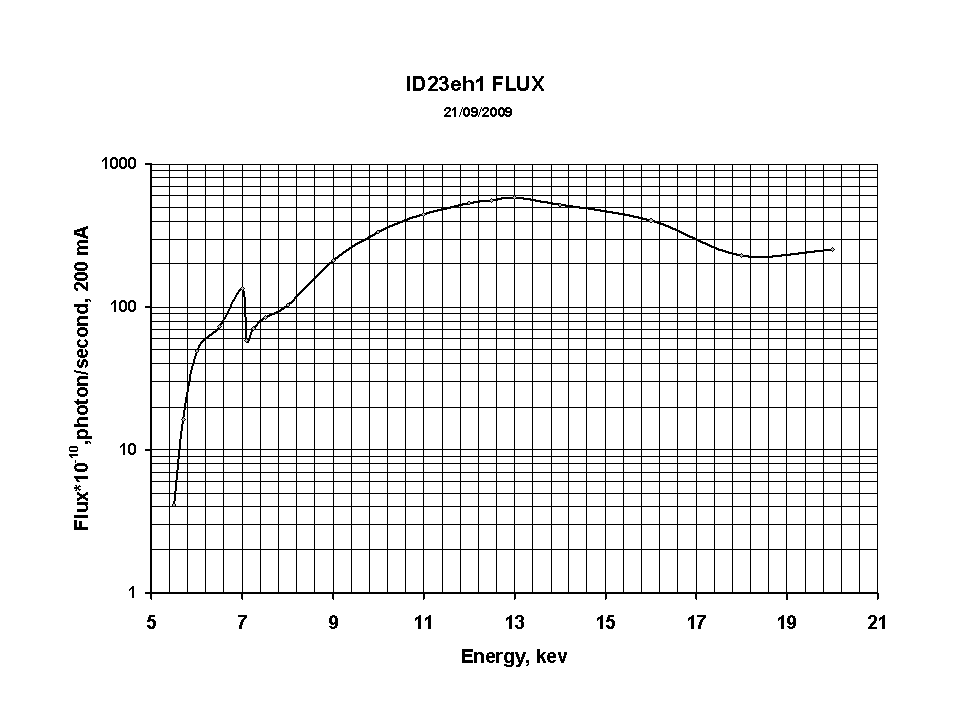Overview
Beamline ID23 is dedicated to macromolecular crystallography experiments. The beamline is composed of two independent end-stations which operate concurrently. ID23-1 is a fully tunable beamline capable of MAD measurements from 6 keV to 20 keV energy. The second station, ID23-2, is fixed energy (14.200keV, 0.873Å) which allows anomalous data to be collected from all of the commonly used heavy scatterers in macromolecular crystallography.
Protein crystal samples are becoming ever smaller, with today's samples typically around 20 to 100 microns in size. ID23-1 uses a high de-magnification ratio of 1:4.5 in order to obtain a small focused beam at the sample position. This choice was a compromise between focal spot size and use of well characterised optical components (in this case bent cylindrical mirror). The X-ray beam profile at ID23-1 has a Gaussian shape, with a FMHM (full width half maximum) dimensions 30 μm vertically and 40 μm horizontally at the sample position.The incident beam intensity is monitored continuously; the monitors are calibrated to an absolute scale(photon/second) over the whole energy range. The exposure time per image at ID23-1 should not be shorter then 0.1 second; in the cases when shorter exposures were needed the beam was attenuated.
High-Throughput and Automation
The beamline is designed to achieve high-throughput measurements in an easily usable and reliable environment. All of the equipment required to perform pre-experiment sample preparation, the measurements and post-experiment processing and backup are at or nearby the ID23 stations: sample preparation (shared and private) next to the stations, data backup, processing and graphics on the beamline and nearby in a dedicated office. The stations are planned to be equipped with sample changers from day one.
The lines are developed to be automatic from the ground up and a beamline "status board" is planned to simplify trouble shooting when problems do arise. The users' experimental environments benefit from state-of-the-art diffractometers and sample changer. Remote semi-automatic sample alignment is possible from the control cabins, with experimental parameters calculated automatically based on pre-set user requirements. In the longer term, fully automatic operations should be possible, with sample changers loading crystals on to the stations and reporting results (even processed data and initial co-ordinates!) back to users at home.
Scientific Applications
ID23 is targeted at high-throughput macromolecular crystallography (MX). Applications of macromolecular crystallography range from solving de novo structures using the multi-wavelength and single wavelength anomalous diffraction techniques for fundamental protein structure to probing active sites with cocktails of molecular fragments to design improved enzyme inhibitors for better drugs.
Structural genomics and proteomics are two new areas of research opening up that make extensive use of macromolecular crystallography. Pipelines of genomics/proteomics targets are being constructed and new structures are already beginning to flow. Over the coming months, many countries and laboratories will develop very efficient high-throughput protein expression, purification and crystallisation programmes and the beamlines need to keep pace.
Available Wavelength Range
The undulator sources give an almost continually tunable wavelength with high intensity over this wavelength range : 0.62 - 2.1 Å (20 - 6.0 keV).

Detector
Since April 2021, ID23-1 is equipped with a Eiger2-16M-CdTe which has an active area of 320 x 370 mm2 (4148 x 4362 pixels, which are 75 microns in size) and can collect 120 images per second.
The X-ray fluorescence detector for automatic absorption edge scanning is a Rontec Silicon drift diode which has an energy resolution of less than 250 eV at 5.9 keV and a maximum count rate of 1 MHz. Coupled with the a series of attenuators on actuators, this detector allows absorption spectra to be automatically recorded on the smallest of crystals as well as concentrated solutions of mother liquor.
Preparation laboratory and Data Processing
A small prep lab is available to users and this contains much of the basic material to prepare samples. Computing facilities are available to process diffraction images, solve crystal structres at the beamline and visualise electron density maps.
Complementary Information
As all other MX-beamlines, ID23-1 is also equipped with an automated sample changer.



